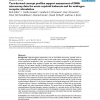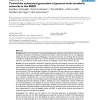BMCBI
2007
14 years 18 days ago
2007
Background: High-throughput experiments, such as with DNA microarrays, typically result in hundreds of genes potentially relevant to the process under study, rendering the interpr...
BMCBI
2007
14 years 18 days ago
2007
Background: Current methods for the automated generation of genome-scale metabolic networks focus on genome annotation and preliminary biochemical reaction network assembly, but d...
BMCBI
2007
14 years 18 days ago
2007
Background: Large molecular sequence databases are fundamental resources for modern bioscientists. Whether for project-specific purposes or sharing data with colleagues, it is oft...
BMCBI
2007
14 years 18 days ago
2007
Background: The availability of microarrays measuring thousands of genes simultaneously across hundreds of biological conditions represents an opportunity to understand both indiv...
BMCBI
2007
14 years 18 days ago
2007
Background: With DNA microarray data, selecting a compact subset of discriminative genes from thousands of genes is a critical step for accurate classification of phenotypes for, ...
BMCBI
2007
2007
Application of amino acid occurrence for discriminating different folding types of globular proteins
14 years 18 days ago
Background: Predicting the three-dimensional structure of a protein from its amino acid sequence is a long-standing goal in computational/molecular biology. The discrimination of ...
BMCBI
2007
14 years 18 days ago
2007
Background: We present a probabilistic topic-based model for content similarity called pmra that underlies the related article search feature in PubMed. Whether or not a document ...
BMCBI
2007
14 years 18 days ago
2007
Background: Information resources on the World Wide Web play an indispensable role in modern biology. But integrating data from multiple sources is often encumbered by the need to...
BMCBI
2007
14 years 18 days ago
2007
Background: Integration of multiple results from Quantitative Trait Loci (QTL) studies is a key point to understand the genetic determinism of complex traits. Up to now many effor...





